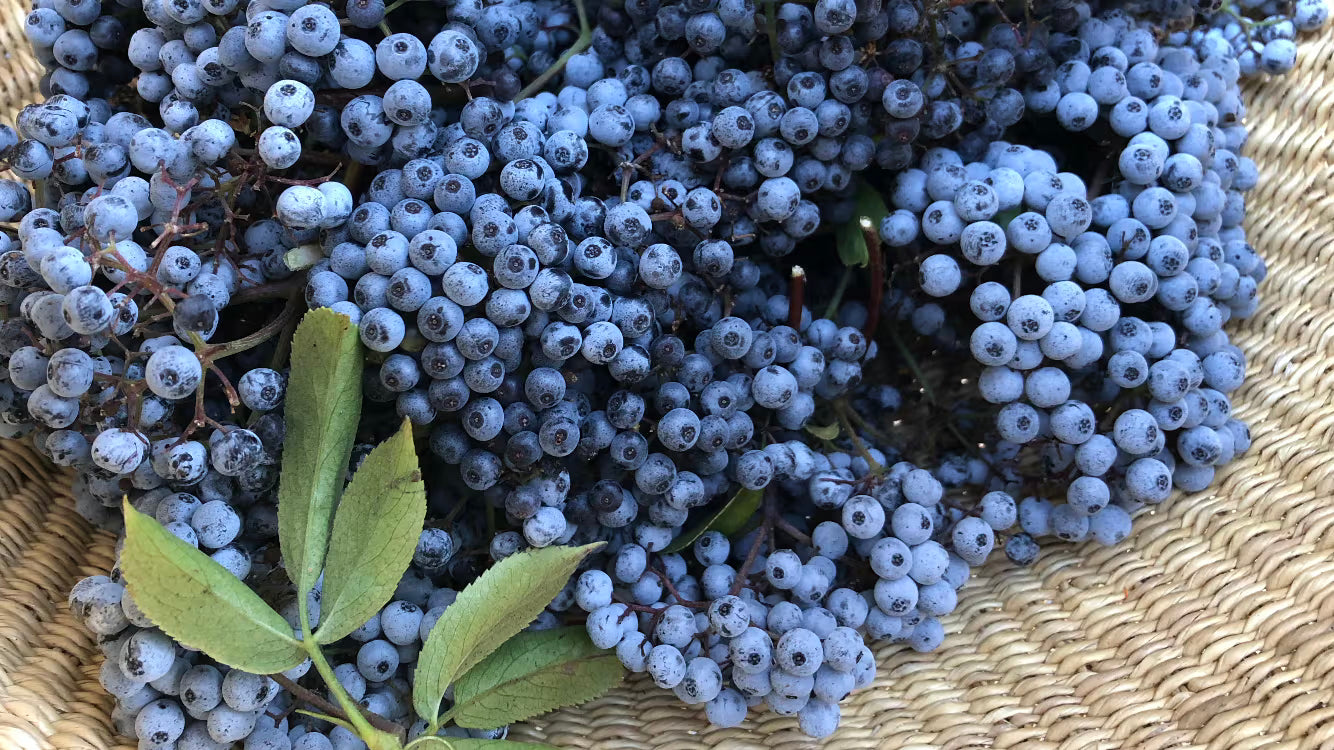
Pictured above: Ripe Elderberries
There are few things more satisfying than filling a pail with plump, sweet, sun-ripened berries on a late summer afternoon -- after the heat of the day has passed, when the shadows are lengthening, and most of the bees have retired from fumbling around the berry blossoms. It is a childhood memory so core to me, I cannot imagine summer without it. If you’re looking for something to make the last few evenings of Summer Break special, before school starts again, here is a cautionary guide to getting young hands in the berry patch.
- NOT ALL BERRIES ARE EDIBLE. As with wild mushrooms, children should first be taught that berries are poisonous, before they are taught that they are edible. Do a little research on your area, and find out what grows that could be potentially poisonous. This is more important than figuring out what is edible! And remember, some berries are edible ONLY when fully ripe, but not before. Never pick green berries.
- Stick to picking 2 or 3 fail-proof varieties of berry that have no poisonous look-alikes. Learn to identify the plant and the flower, not just the berry itself. For example, for my region in The Bay Area, I know that Blackberry, Mulberry, and Elderberry are edible, and I am familiar with the environments in which they are likely to grow.
- Many of the edible wild plants that are most prolific and easy to identify are what we call “ditch weeds,” meaning that for some reason, they thrive best in the worst of all possible conditions. If you’re foraging in an urban environment, you’ll often find the most beautiful and prolific plants growing in construction sites, parking lots, under over-passes, and along the sides of busy interstates. This is frustrating, and a major tease, because these are the worst environments in which to forage. Construction chemicals, heavy metals, and exhaust end up in the runoff and groundwater, feeding the plants, and potentially feeding you! Though it may be tempting, avoid foraging in areas where there is evidence of heavy traffic. If you live in a sleepy neighborhood with quiet cul-de-sacs, it should be fine for berry picking. If you’re dodging cars to pick something in a highway median, or climbing a chain link fence into a construction site, not so much. Keep in mind highly manicured areas, like golf courses, where pesticides and herbicides may have been sprayed by landscapers.
- Good places for berry picking are local parks, ponds, and walking trails. Little-used country roads outside of town, where there are ample roadside areas for pulling over, and along fencerows in open farmland. Just make sure that you are not trespassing on private property. Most places do not have policies against picking a few handfuls of wild berries, but look up local foraging laws in your area, as they may differ between local and state parks.
- Blackberries, the most common and easy to identify of all wild berries in the US, grow on sprawling vines covered in wickedly snagging little thorns. Make sure you and any blackberry-picking children are thoroughly covered. Wear gardening gloves, long sleeves, and pants. Learn to identify Poison Ivy and Poison Oak, as they are more common even than Blackberries, and the two plants love to grow intertwined. As an extra precaution, these Poison Oak and Ivy Wipes make a handy addition to your foraging kit.
- Elderberries, also easy to identify, differ from most berries in that they cannot be eaten raw. Never set out to pick Elderberries expecting to snack on them right off the tree. The berries must be fully cooked, or else they can cause serious stomach upset. The berries must also be removed from the stems, which contain cyanide. If this all sounds too scary to bother with, don’t worry. Once cooked, Elderberries are one of the most medicinal wild fruits availabe, and you can expect to pay high prices in health food stores for products made with Elderberry.
- If you’re doing it right, picking ripe berries of any kind will quickly create a juicy situation all over you and any vessel you use to collect them. With gravity, the berries on the bottom will soon become squished by the weight of those above them. Care should be taken when selecting a picking pail. A 5 gallon bucket is traditional, but we have found that a stack of 32oz deli containers with lids works well to keep berries uncrushed.
- Just like the last days of summer, freshly picked wild berries do not last long. Perhaps that is part of their charm. If you don’t eat them right off the vine or out of the bucket, you should try to use them the day they were picked. If you don’t want to get crazy with a pie or cobbler, try just cooking the whole berries down with your desired amount of sugar, and serving them over ice cream. Make sure you wash them first, because we are not the only critters that enjoy fresh berries, and you are likely to find a few six-legged hitchhikers in your harvest.
- If you have picked more than you can eat, berries can be stored in gallon Ziplock bags and frozen for up to 6 months. If you lay the bags out in flat layers to freeze, you will save yourself space, as well as cut down on freezer burn and a lower layer of mushy crushed berries.
- Have fun and be safe!
